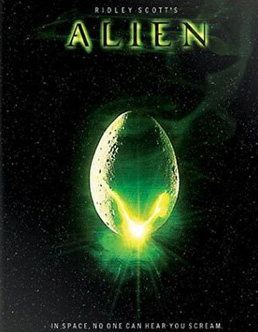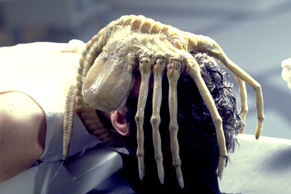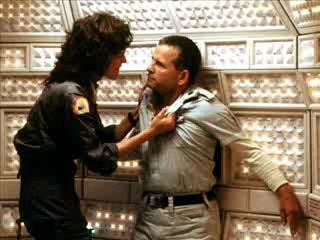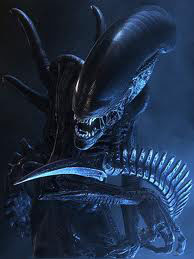
TECHNO-TOTALITARIANISM IN ALIEN
by Dan Dinello
The opening of Ridley Scott’s Alien (1979)introduces the Nostromo—a rusted-out, factory-like spaceship travelling in space and functioning without people. Languorous interior pans and tracking shots present an exclusively technological environment: an autonomous, self-sustaining cybernetic organism that obviates the need for human control. Signifying its importance relative to human involvement, an apparently self-activated computer interface flashes to life and reflects in the glass surface of an empty space-helmet. Lights blink on and a door slides open. Small and irrelevant, the human crew sleeps cocooned in tube-like compartments, demonstrating their helpless reliance on the technological system that operates the ship and regulates their life support. As early technology critic and sociologist Jacques Ellul stresses in The Technological Society, “The character of technique [whether a system or a machine] renders it independent of man himself.”
Alien offers a pessimistic vision of humanity dominated by a technological empire. Programmed by an unethical corporation called the Company, technology emerges as a ubiquitous, insidious, and totalitarian force. The human victims of the technological system have been so conditioned to its rule that they perceive its stranglehold as the natural state of things, not even recognizing their enslavement. Reflecting the philosophy of techno-critics Ellul and political scientist Langdon Winner, Alien dramatizes the idea that “Technology is a source of domination that effectively rules all forms of modern thought and activity. Whether by an inherent property or by an incidental set of circumstances, technology looms as an oppressive force that poses a direct threat to human freedom.”
Ellul’s The Technological Society and Winner’s Autonomous Technology together express a comprehensive indictment of technology, both arguing extensively for its perilous and autonomous nature. Ellul defines technology more broadly as “technique”: machines, political organizations and economic systems that value efficiency and order beyond all else. The technique of a system or machine subjugates humans to the point where the demands imposed by technical requirements stifle spontaneous, free behavior. Winner expands Ellul’s notion that “Technique cannot be otherwise than totalitarian. Technique causes the state to become totalitarian, to absorb the citizen’s life completely” and focuses on technological politics and the question of whether technology is out of control. To Ellul and Winner, men are not the masters of technology, they are its slaves; this is a point made clear in Alien as the asymmetrical relationship between humans and technology unfolds on the Nostromo.
Mother Demands Obedience
Directing the ship and controlling its environment, the computer interrupts the Nostromo’s journey home, awakening the crew and forcing them to risk their lives investigating an alien signal on a nearby planet. The computer’s name, “Mother,” reinforces the humans’ childlike dependence on it and perpetuates the false image of technology as protective and nurturing. The computer’s name also introduces the notion of perverse or technological reproduction, a fearful motif of numerous science fiction horror stories from Mary Shelley’s 1818 novel Frankenstein to Vincenzo Natali’s 2009 film Splice. When awakened by Mother, the crew members emerge, nearly-naked, from their womb-like compartments as if they have been birthed. The opening of Alien therefore suggests that the crew, as children of a computer mother, are themselves quasi-technological entities, parts of a machine.
Realizing that Mother wants them to embark on a new mission rather than go home, two crew members protest against investigating the unknown transmission. They argue that their contract does not obligate them to do so, a claim quickly refuted by both science officer Ash and Captain Dallas who reinforce Mother’s investigative demands. In this regard, Captain Dallas—earning a higher pay—sells out not only his crewmates but also himself as he later gets rewarded with death for serving as an instrument of corporate ideology. Ash—quoting the contract’s fine print—insists that failure to follow orders will result in “no money.”
Beyond the threat of not being paid, the crew has no choice in the matter: the computer controls the ship, they do not. Quickly, the crew acquiesces to Mother’s demands. As it turns out, this supposedly protective mother—programmed by the Company—will betray her children and permit infanticide. As such, Mother joins a science fiction history of evil computers: Alpha 60 in Jean-Luc Godard’s Alphaville (1965), HAL in Stanley Kubrick’s 2001: A Space Odyssey (1968), Colossus in Joseph Sargent’s Colossus the Forbin Project (1970), Proteus IV in Donald Cammell’s Demon Seed (1974) and AM in Harlan Ellison's 1967 novella “I Have No Mouth and I Must Scream.” Unlike Mother, these previous computers are gendered male, express arrogance, and act overtly to dominate humans. Mother, on the other hand, evokes female protectiveness, expresses stubbornness, and acts subversively. Like the other computers, Mother shares a disregard for human life but, uniquely, its murderous actions stem directly from the exploitative intent of the corporation that programmed it. Alien links technological dominance to ruling class power.
When Second-in-Command Ellen Ripley finally gains access to the computer following the death of the captain, she learns that the crew has been deemed “expendable” and that the Company’s first priority is capturing the alien. The Company wants to use the creature as a component of a biological weapons system that will prove profitable. The unseen Company is the central monster of Alien: all the evil flows from its capitalistic and technological imperatives. A monolithic entity, the Company represents corporate totalitarianism: it deploys vast technological systems to enforce its interests while generating a bright aura of rationality and common sense to justify its designs.
The crew members are so blind to their technologically enslaved states that none of them question the Company’s right to make demands that jeopardize their lives. No one challenges the morality of the contract or tests the consequences of non-compliance. Their acquiescence persists, even as the crew members are killed off one by one for no known purpose other than to ensure the survival of the alien, demonstrating the extremes to which such blind enslavement can lead. Only at the end, when it's too late, do they offer any resistance to technological authority.
All the humans must be transformed into technological components to suit the special needs and objectives of the corporate technical system, in this case Mother and the spaceship Nostromo. As the children of a computer, the individuals operate as mere cogs in the machine. Anyone who does not function efficiently will be deemed “expendable.” This instance of what Winner calls “technological politics” epitomizes how the corporate ruling class—through its control of technology—manipulates the decisions and needs of society to match its own interests and to deftly make the whole arrangement appear rational, necessary, and free. Winner argues that “Human beings still have a nominal presence in the network, but they have lost their roles as active, directing agents . . . . They tend to obey uncritically the norms and requirements of the systems which they allegedly govern.” The importance of human beings emerges exclusively in relation to their capacity to serve assigned functions in the technological system whose demands, needs, and objectives assume paramount importance.
Obeying Mother’s directive to investigate the planet, the crew discovers another monstrous mother: an alien ship that itself looks like two legs spread apart. Entering through a vaginal opening, the investigative team finds that the biomorphic vessel is pregnant with alien eggs in a womb-like chamber. Crew member Kane foolishly takes a close look at one of the pulsating eggs and a lecherous, crab-like being bursts out of it, clamping to his face, wrapping a tail around his neck, and inserting one end of its writhing body into the struggling man’s mouth in a parody of rape. Still clinging to Kane’s face, the alien “face-hugger” is transported inside the ship. While Ripley refuses Kane re-entry on the grounds of possible contamination, science officer Ash counteracts her order, first in the name of scientific research and then in the name of Company objectives.
Killing Machine
Unbeknownst to the crew, Ash is an android and, like the computer Mother, has been programmed by the Company to ensure capture of the alien at any cost. Significantly, it is Ash who explains to the protesting crew that their contract with the Company stipulates that they must investigate “any transmission indicating a possible intelligent origin.” A technological extension of the Company, Ash becomes a robotic monster that sabotages the crew’s welfare when it conflicts with Company interests. Utterly indifferent to human life, Ash uses the hapless, submissive humans as disposable instruments in his effort to capture and then protect the alien to secure profits for the Company’s biological weapons division. The ostensible human masters of technology are themselves mastered by it in the form of robot Ash.
Designed to penetrate and manipulate the human crew undetected, Ash’s technological composition remains unknown to the humans. His workspace is decorated with semi-pornographic pin-ups, reflecting his misogynistic programming and serving to disguise him as a typically macho male. Despite a supercilious attitude, he is trusted because he is so much like his colleagues. The robot’s invisibility and unnoticed manipulations reflect modern technology’s penetration into the world: technological systems have become so ubiquitous and so much a part of everyday life that they operate as part of the natural environment. For example, the changes, disruptions, restrictions and chilling effect of evolving widespread surveillance technology—including networked cameras, data mining algorithms, electronic transponders, GPS-embedded cell phones, facial recognition software, biometric and personal information databases, and the arrival of domestic drones—have been mostly accepted as the price to be paid for security and convenience.
Ash tries to remove the face-hugger from Kane, not to save the human but to save the alien. But the crab-like lifeform tightens its tail around Kane's neck while dripping ship-destroying acid blood. Shortly thereafter, the alien disappears after surreptitiously dropping an egg into Kane where it gestates within his body. Kane seems fine. He gets up and eats voraciously, to all appearances normal. But, like a uterus, Kane’s body serves the alien parasite as a source of nutrients and protection from the environment. After a brief incubation time, a penile creature with teeth is “born” by literally bursting out of the host’s stomach. The creature quickly metamorphoses into a humanoid techno-surrealist killing machine. Android Ash aligns himself with the alien, inspired by its structural perfection, technological “purity,” and unstoppable ruthlessness.
Ash’s correspondence with the alien becomes even more direct when he attempts to defend it from Ripley’s attack. In an echo of the quasi-rape of Kane and lacking a penis himself, Ash rolls up a pornographic magazine from his stash and forces it down Ripley’s throat to suffocate her. Two crew members come to her defense and stop the attack, only realizing that Ash is a technological creature after lopping off his artificial head.
Technological Monster
A projection of the techno-totalitarian ideal, the alien parasitizes humans, commandeers their organic machinery, and forces them to serve as its reproductive hosts. In this sense, the alien symbolizes the Company’s capitalistic voraciousness and its parasitic employment of the crew to serve the corporate agenda. A techno-organic hybrid, the alien also represents the horrors of the Company’s weaponized technology and, more generally, exploits fears of perverse sexuality and reproduction. With its mechanized protruding teeth, its battery-acid blood, its reproductive resemblance to a virus, and its metallic appearance that blends with the spaceship’s pipes and wires, the alien evokes “futuristic machinery, skeletons, and verminous insects: a necrotechnological nightmare.
Like a viral infection, technology evolves as an autonomous, invasive force that expands and fulfills its dangerous potential by reproducing and spreading through humans. Voracious in its urge to possess and engulf, technology is a parasite that frequently undermines human integrity, invisibly infiltrating, controlling, and mutating its human host to support its own survival and evolution. This view of technology as an independent, quasi-biological lifeform reduces humans to secondary status, as mere carriers of the techno-contagion. Like the alien, the technological virus uses humans as a breeding ground that combines and recombines technological structures to produce new mutations that may—in the form of horrific weapons—ultimately result in the extinction of humanity. Winner observes, “Each generation extends the technical ensemble and passes it on to the next generation. . . . The mortality of human beings matters little, for technology is itself immortal and, therefore, the more significant part of the process.”
Ellul draws similarly bleak conclusions about the role of humans in technological evolution: “Technique pursues its own course more and more independently of man. This means that man participates less and less actively in technical creation, which, by the automatic combination of prior elements becomes a kind of fate. Man is reduced to a catalyst.”
The technological virus undermines the human dream of control, demonstrating that it has gone awry in reality. In its vision of anti-human machine-monsters, Alien questions the notion that technology is neutral, simply a means to an end. Far from being neutral, our technology reveals itself as self-perpetuating and self-enhancing, growing and changing automatically apart from human desires and calculations.
“Human beings still have a nominal presence in the technological network,” says Langdon Winner, “but they have lost their roles as active, directing agents. They tend to obey uncritically the norms and requirements of the systems which they allegedly govern. As such, the plague of technology, operating as a pervasive totalitarian force, thwarts human control and tends to modify and dominate the environment, psychology, motives, and behavior of society. “America is addicted to oil,” said President George Bush, in his 2006 State of the Union address, at the height of the Iraq War. But, that is not quite right: our machines are addicted to oil. As such, society must be organized, to an extent, around the acquisition of oil whether through war, exploitation, or environmentally dangerous exploration. In this sense, humans become slaves to technology, even sacrificing their lives to its expansion.
Technology in Control
The technological systems of the Nostromo run independently of even the Company’s control. At the end of the film, Ripley initiates the mechanism that will destroy the spaceship in ten minutes. The device is clearly marked with an apparently failsafe cut-off method for stopping the self-destruction. During the countdown to the Nostromo’s end, Ripley changes her mind. She fulfills the failsafe system’s requirements but the destruction mechanism continues anyway. Ripley curses Mother, blaming the computer for ignoring her desire to stop. The self-destruct system is so “efficient” once initiated that it cannot be reversed by human override even though destroying the Nostromo undermines the Company’s interest. As Ellul puts it, “Man no longer possesses any means of bringing action to bear upon technique. He is unable to limit it or even to orient it. Technique is essentially independent of the human being who finds himself naked and disarmed before it.” Ellul’s comment brings to mind the literal near-nakedness of the crew, at the beginning of Alien, sleeping cryogenically under complete control of the Nostromo’s technological systems as well as Ripley’s near-nakedness at the end of Alien just prior to being attacked by the techno-monster.
Despite her vulnerable state, Ripley rises up and defeats the last representative of techno-totalitarian force, the alien monster itself. In a final evocation of the film’s reproductive motifs, Ripley asserts sovereignty over her own body and, in an act of abortion, blasts the alien into space, even severing its umbilical cord. This conclusion seems to soften the techno-totalitarian theme of the film. Though the entire crew save Ripley has been killed, the Company’s technology—the robot, the computer, the Nostromo and the alien—have been destroyed. One of cinema’s greatest monster fighters, Ripley appears to demonstrate that a tough, independent, resourceful human being can free herself from the forces of technological domination. But, this interpretation is wrong: despite the temporary uplift, Alien ends on a deeply pessimistic note.
Ripley’s victory over the monstrous substitute for corporate technology—the alien—leaves the invisible techno-totalitarian system intact. She remains completely dependent upon the same Company technology that functioned to capture and protect the alien and that characterized her life as “expendable.” She anthropomorphizes the technology and subordinates her role when she titles her last log entry as the “final report of the starship Nostromo.” She then returns to cryogenic sleep, putting her trust back into the techno-protection of the Company-controlled computer that operates the shuttle and regulates her life support system. Beyond that, she hopes to return to the Company, whose expensive robot and spaceship she’s destroyed and whose profit-producing alien she’s blasted into space. The Company will not be happy to see her; they would rather the alien were on board.
Alien paints a gloomy picture that depicts humans as the victims of ubiquitous, oppressive technological forces that reflect the moral flaws and authoritarian impulses of its corporate designers. Ripley has no choice but to once again place her faith in the Company's technological systems in order to survive. She and her now-dead crewmates put themselves in a position of extreme, even pathological dependence upon technology that is seemingly too complex to understand or control. Though Ripley defeats the individual representatives of technology, she remains at the mercy of the techno-tyrannical system that still dominates her.
Bibliography
Ellul, Jacques. The Technological Society. Translated by George Wilkinson., 1954. Reprint, New York: Knopf, 1964.
Skal, David. Screams of Reason: Mad Science and Modern Culture. New York: W. W. Norton, 1998.
Winner, Langdon. Autonomous Technology: Technics-out-of-Control as a Theme in Political Thought. Cambridge, MA: MIT Press, 1977.
I



